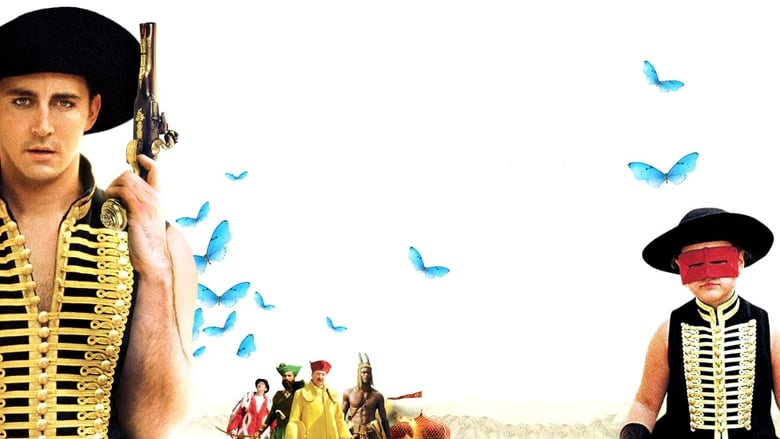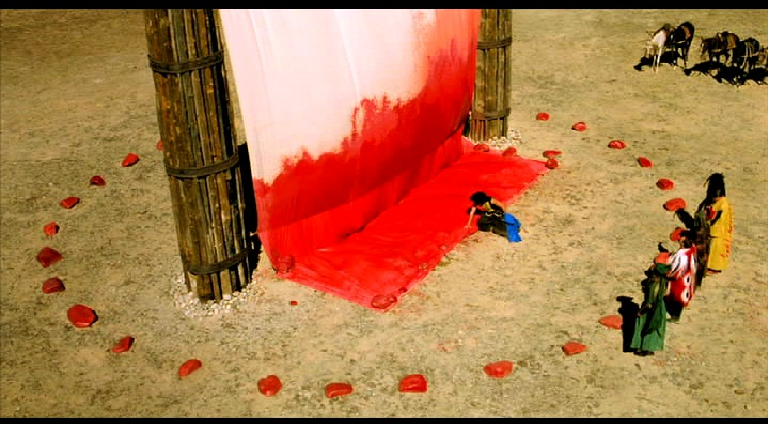← Back to Reviews

in
There are many types of repeated visual motifs in the film (some mentioned earlier) but I really see Tarsem seeing faces in buildings and landscapes (and vice versa) a lot. By far the most sophisticated of these shots occurs during the "wedding scene" at 1:12:19. We see the head of the "stony-faced priest" who betrayed the heroes. He's wearing a huge, elegant, raised, off-whitish collar with a lower black garment which appears similar to a priest's collar with a piece extending downward. His short black hair is shaved on top. The shot dissolves into a high desert landscape which has all the same shapes and colors in it. The top of his head turns into a snowcrested mountain in the background, the sides of his fancy collar turn into supporting mountains and shapes in the desert sand, just as his eyes, nose and sadistic smile do. Then the black collar at the bottom becomes a raised tee-shaped sacrificial platform. It's really incredible to see. I had to freeze it and then keep hitting the pause button so I could see how gradually and perfectly the transition was. Tarsem is obviously a visionary artist of the highest magnitude. Actually after the scene became desert and mountains, I was sure that the outlines in the sand resembled a lion's mane. Then a little weird thing came out of the eye and turned into... I'll leave it a secret. But I don't think there's much if any computer doctoring in there at all. It just looked like real photography and an old-school dissolve, but you tell me.

The Fall (Tarsem [Singh], 2008)
I rewatched The Fall and I'll address some of the comments and concerns of others, but what I really want to do is discuss specifically some of the mind-blowing visuals in the film and tell you where they occur in the movie so you can check them out if you wish. I've seen the film three times now, and if anything, I think it gets better with added viewings so I wouldn't be afraid of rewatching it, Godoggo. The story always made sense to me but this time I have to admit that it was more touching, never seemed to grow slow and turned into a lovely paean to silent filmmakers and stuntmen, especially a few of the greats who did their own stunts and who we see at the film's glorious finale. It goes without saying that it's also a Valentine to childhood imagination. I didn't realize that The Fall is actually a remake of a Bulgarian film called Yo Ho Ho which has a very similar plot but all I've seen of it is a trailer with no subtitles.
I rewatched The Fall and I'll address some of the comments and concerns of others, but what I really want to do is discuss specifically some of the mind-blowing visuals in the film and tell you where they occur in the movie so you can check them out if you wish. I've seen the film three times now, and if anything, I think it gets better with added viewings so I wouldn't be afraid of rewatching it, Godoggo. The story always made sense to me but this time I have to admit that it was more touching, never seemed to grow slow and turned into a lovely paean to silent filmmakers and stuntmen, especially a few of the greats who did their own stunts and who we see at the film's glorious finale. It goes without saying that it's also a Valentine to childhood imagination. I didn't realize that The Fall is actually a remake of a Bulgarian film called Yo Ho Ho which has a very similar plot but all I've seen of it is a trailer with no subtitles.
Right from the opening black-and-white credits depicting the aftermath of one of the many Falls in the film, set to Beethoven's 7th Symphony, An Arpeggio, the viewer is grabbed by the uniqueness of this movie. We don't really understand that it's a silent film stunt gone wrong, and we don't know that some of the characters which we see later in the fantasy stories are introduced in this impressionistic opening, but we do know that what we're seeing has been planned out with extreme care and a high level of artistry. Yes, when the stunt man (Lee Pace) tells his story to the girl (Catinca Untaru), he basically provides the plot and some of the faces of the characters, but she visualizes everything herself and adds the identities of others, and you have to remember that she has never seen a movie.
While this adds some possible anachronisms and anomolies, it also adds to the visual imagination apparent on screen at all times but especially during the fantasy stories. Some of the shots and transitions seem to be just too incredible to be reproduced so perfectly, so I will give that credit to director Tarsem and his skilled artists and technicians over and above the darling girl Alexandria (the Great). An early example of this is when one of the Bandit Heroes, Charles Darwin (yes, that guy), is given a beautiful butterfly by the Villain of the piece, Odious. Darwin is aghast to find the winged creature pinned inside a box on a blue-colored field of some material. We see a closeup of the butterfly and the camera circles around it as it turns into Butterfly Reef in the middle of the ocean, the place where the Bandits are exiled by Odious. In fact the pin seems to turn into the five bandits gradually. This scene begins at 22:17 on the DVD. As it continues, we soon learn that Darwin is being aided and actually taught by a monkey who is certainly smarter than him and almost seems to possess psychic powers. So whatever else you think of the flick, I hope you appreciate its humor.


There is a brief image of a grey, cloudy sky which appears at 44:28 on the DVD. All three of us watching the movie took turns telling what images we saw in that sky (consisting of only clouds) and going up to the screen to point them out. We could all see them too, once referenced, and no, we weren't stoned. How intentional those "images" were I don't know, but based on everything else on display in this film, I'd say there was a definite reason that specific two seconds was put on screen. We saw, among other things, a werewolf's head, a lion, a donkey, a horse, the head of a bird (maybe an eagle), and in some form of magic, one particular area in the center seemed to resemble three things basically using up the same space. We decided those three were a horned demon's head, Oogie Boogie from The Nightmare Before Christmas and Aladdin's Lamp! I hope some people will pause that shot and look at it very closely because it's a lot of fun and I'll bet that you may see some things and interpret them differently. Sometimes a full-on shot would morph into a profile or a head would look more like a body, but there is something very hypnotic in that shot and I don't believe it's been doctored at all. Then again, I'm a cloud fetishist and have taken hundreds of pictures of them based on what I see there.
There are many types of repeated visual motifs in the film (some mentioned earlier) but I really see Tarsem seeing faces in buildings and landscapes (and vice versa) a lot. By far the most sophisticated of these shots occurs during the "wedding scene" at 1:12:19. We see the head of the "stony-faced priest" who betrayed the heroes. He's wearing a huge, elegant, raised, off-whitish collar with a lower black garment which appears similar to a priest's collar with a piece extending downward. His short black hair is shaved on top. The shot dissolves into a high desert landscape which has all the same shapes and colors in it. The top of his head turns into a snowcrested mountain in the background, the sides of his fancy collar turn into supporting mountains and shapes in the desert sand, just as his eyes, nose and sadistic smile do. Then the black collar at the bottom becomes a raised tee-shaped sacrificial platform. It's really incredible to see. I had to freeze it and then keep hitting the pause button so I could see how gradually and perfectly the transition was. Tarsem is obviously a visionary artist of the highest magnitude. Actually after the scene became desert and mountains, I was sure that the outlines in the sand resembled a lion's mane. Then a little weird thing came out of the eye and turned into... I'll leave it a secret. But I don't think there's much if any computer doctoring in there at all. It just looked like real photography and an old-school dissolve, but you tell me.

Whether you care about these kinds of things or not I'm not sure. You may just want to watch the movie straight through and seek them out after it's over, but I can't help but think that everyone would at least want to check some of these out and draw their own conclusions about how they support and embellish the story because I don't consider them to be just show-offy flourishes.
I could go on here, but it's late and I'll wait for some (hopeful) responses before I get into more specifics about what things may or may not mean, but my bottom line is that I believe it's an excellent story told by someone who was totally devoted to what they were doing. I can see it fitting into the "blockbuster" category because the pure joy of filmmaking, especially of a fantastic nature, is apparent in every shot and scene.
